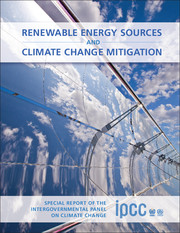 Renewable Energy Sources and Climate Change Mitigation
Renewable Energy Sources and Climate Change Mitigation Book contents
- Frontmatter
- Contents
- Section I
- Section II
- Section III
- Chapter 1 Renewable Energy and Climate Change
- Chapter 2 Bioenergy
- Chapter 3 Direct Solar Energy
- Chapter 4 Geothermal Energy
- Chapter 5 Hydropower
- Chapter 6 Ocean Energy
- Chapter 7 Wind Energy
- Chapter 8 Integration of Renewable Energy into Present and Future Energy Systems
- Chapter 9 Renewable Energy in the Context of Sustainable Development
- Chapter 10 Mitigation Potential and Costs
- Chapter 11 Policy, Financing and Implementation
- Section IV
- Index
- References
Chapter 8 - Integration of Renewable Energy into Present and Future Energy Systems
Published online by Cambridge University Press: 05 December 2011
- Frontmatter
- Contents
- Section I
- Section II
- Section III
- Chapter 1 Renewable Energy and Climate Change
- Chapter 2 Bioenergy
- Chapter 3 Direct Solar Energy
- Chapter 4 Geothermal Energy
- Chapter 5 Hydropower
- Chapter 6 Ocean Energy
- Chapter 7 Wind Energy
- Chapter 8 Integration of Renewable Energy into Present and Future Energy Systems
- Chapter 9 Renewable Energy in the Context of Sustainable Development
- Chapter 10 Mitigation Potential and Costs
- Chapter 11 Policy, Financing and Implementation
- Section IV
- Index
- References
Summary
Executive Summary
To achieve higher renewable energy (RE) shares than the low levels typically found in present energy supply systems will require additional integration efforts starting now and continuing over the longer term. These include improved understanding of the RE resource characteristics and availability, investments in enabling infrastructure and research, development and demonstrations (RD&D), modifications to institutional and governance frameworks, innovative thinking, attention to social aspects, markets and planning, and capacity building in anticipation of RE growth.
In many countries, sufficient RE resources are available for system integration to meet a major share of energy demands, either by direct input to end-use sectors or indirectly through present and future energy supply systems and energy carriers, whether for large or small communities in Organisation for Economic Co-operation and Development (OECD) or non-OECD countries. At the same time, the characteristics of many RE resources that distinguish them from fossil fuels and nuclear systems include their natural unpredictability and variability over time scales ranging from seconds to years. These can constrain the ease of integration and result in additional system costs, particularly when reaching higher RE shares of electricity, heat or gaseous and liquid fuels.
Existing energy infrastructure, markets and other institutional arrangements may need adapting, but there are few, if any, technical limits to the planned system integration of RE technologies across the very broad range of present energy supply systems worldwide, though other barriers (e.g., economic barriers) may exist. Improved overall system efficiency and higher RE shares can be achieved by the increased integration of a portfolio of RE resources and technologies.
- Type
- Chapter
- Information
- Renewable Energy Sources and Climate Change MitigationSpecial Report of the Intergovernmental Panel on Climate Change, pp. 609 - 706Publisher: Cambridge University PressPrint publication year: 2011
References
- 31
- Cited by


